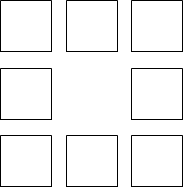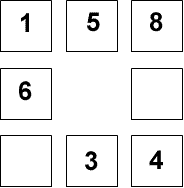Polo square
Problem
You may have seen Magic Squares before, where each row, each column and each diagonal adds to the same total. (Have a look at the problem called Magic Squares for an example.)
Here is a Polo Square:

You can see that eight numbers could be arranged in the Polo Square - one in each box. In our Polo Square, the eight numbers can be chosen from the counting numbers $0$ to $9$ inclusive. A number cannot be used more than once. Each side of the Polo Square must add to the same total - we can call this the Polo total.
Here is a partly completed Polo Square:

What is the Polo total?
Can you complete the Polo Square?
Can you find other ways of making a Polo Square with the same Polo total?
What other totals are possible?
Is there more than one way of making each one?
Many thanks to Alan Parr for this investigation. Alan has written several problem-solving maths adventures for 10 and 11 year-olds. The games are easy to use and very popular with children. Details can be obtained from Alan at alanparr@dial.pipex.com
Getting Started
What is special about the numbers in the corners?
What exactly are you looking for?
What totals are impossible?
Student Solutions
Solutions gathered by Alan after RI lecture:
|
Polo total |
Number of distinct responses |
|
9 |
2 |
|
10 |
6 |
|
11 |
10 |
|
12 |
13 |
|
13 |
10 |
|
14 |
5 |
|
15 |
12 |
|
16 |
8 |
|
17 |
3 |
|
18 |
3 |
In fact, Cecilia, Anna and David have emailed us to say that they think the above table isn't quite right.
They suggest the following:
|
Polo total |
Number of distinct responses |
|
9 |
3 |
|
10 |
6 |
|
11 |
10 |
|
12 |
13 |
|
13 |
10 |
|
14 |
10 |
|
15 |
13 |
|
16 |
10 |
|
17 |
6 |
|
18 |
3 |
They say:
It is possible that we lack some solutions, but what is absolutely certain is that the list must be symmetric since for every solution in which each row and column add N we can find a solution in which each row and column add 27-N, with the following procedure:
a b c 9-a 9-b 9-c
d e 9-d 9-e
f g h 9-f 9-g 9-h
Thank you!
